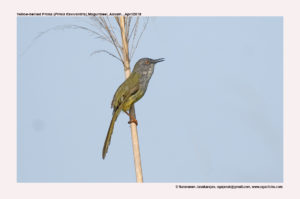Yellow-bellied Prinia

Yellow-bellied Prinia Prinia flaviventris
Etymology:
- Prinia : Javanese name Prinyafor the Prinia
- Flaviventris: Latin word flavus-yellow; ventris- belly { Yellow Belly}
Vernacular Names: Pun: Pilipiddi
Distribution in India: Resident of North East and some parts of North India.
Description: of 12–14 cm; wt. of 6–11·9 g. It is an attractive, fairly distinctive Prinia with long graduated tail. The nominate race in non-breeding plumage has crown, nape and sides of head grey, lores and ear-coverts darker, indistinct whitish supercilium becoming diffuse behind eye; upperparts are olive-green, brightest on rump and uppertail-coverts. It has grey-brown wing feathers edged olive-green. The tail is olive-brown; feathers are with greenish fringes and only slightly paler tips. The throat and breast are creamy white, becoming lemon-yellow on belly, lower flanks and undertail-coverts. The thighs are rufous-buff; iris is reddish brown to dark red; maxilla are pale horn-brown, mandible is flesh-coloured; legs are yellowish brown to fleshy yellow. .The breeding plumage is similar, but tail appears shorter and can be bleached pale when heavily worn. The male has black bill and gape. Both the sexes are similar, female as non-breeding male. The juvenile lacks grey on head, is dull olive-brown above, wing feathers edged rufous-brown, washed yellow below, eyes are pale and mandible is yellowish.
Habitat: It is found in tall grasses and reed beds, riverine floodplains, marshes, paddy fields, canals, lake sides, riversides, tamarisk thickets and grassy edges at landward side of mangroves. It is found from sea-level up to 1530 m.
Food habits: It eats insects and their larvae, small flies, grasshoppers and crickets, ants, small beetles, lepidopteron caterpillars; small spiders and small butterflies. It is found singly or in pairs. It is unobtrusive, keeping well hidden in grass, feeding close to ground. It occasionally climbs up stalks while gleaning for insects, then weakly flutters low for a few meters to work another spot.
Breeding habits: They breed in Apr–Oct in North India and Pakistan; Jan–Sept in South East Asia, and Jan–Aug in lowlands of Borneo, Dec–Mar in Kelabit uplands. The breeding display is a song flight in jerkily undulating circle before re-alighting. Both the sexes co-operate in nest building, The nest is oval-shaped made of coarse grasses mixed with finer grasses, grass roots and vegetable down , enhanced by cobweb and lined with finer grasses. The nest is built around supporting strong upright grass stems or hang from drooping twigs of small shrub, situated above ground. They lay a clutch of 3-4 eggs. The incubation is done by both sexes for 14–15 days. The nest is parasitized by Plaintive Cuckoo.